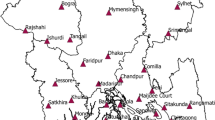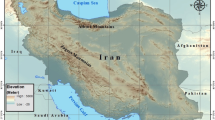Summary
In this paper, a new method of cluster analysis incorporating a statistical test, was proposed in order to decide whether to accept or reject the assumption of a numerical classification of climate according to aχ 2 test. On the basis of normality of errors, theχ 2 test has been derived from the variance of the Euclidean distance or from that of the reduced distance.
This new method of cluster analysis consists of uniform clustering and central clustering. The former is adapted to a more detailed numerical classification of climate, while the latter is appropriate for the large-scale numerical classification of climate. Examples of calculation and application of this new method of cluster analysis are presented in order to illustrate calculations undertaken in the processes of climate classification.
Similar content being viewed by others
References
Balling, R. C., 1984: Classification in Climatology. In: Gaile, G. L., Willmott, C. J. (eds.)Spatial Statistics and Models. Dordrecht: D. Reidel.
Barry, R. G., Perry, A. H., 1973:Synoptic Climatology, Methods and Applications. London: Methuen, pp. 279–282.
Brandt, S., 1983:Statistical and Computational Methods in Data Analysis. Amsterdam: North-Holland, pp. 191–196.
Cramér, H., 1946:Mathematical Methods of Statistics. Princeton: University Press, pp. 352–358.
Davis, J. C., 1973:Statistics and Data Analysis in Geology. New York: Wiley, pp. 191–196.
Hoel, P. G., 1963:Introduction to Mathematical Statistics. New York: Wiley, pp. 160–163.
Krzanowski, W. J., 1988:Principles of Multivariate Analysis. Oxford: Clarendon, pp. 25–32.
Lang, R., 1915: Versuch einer exakten Klassifikation der Boden in klimatischer und geologischer Hinsicht. Intern. Mitt. f. Bodenkunde; Verwitterung und Bodenbildung als Einführung in die Bodenkunde, Stuttgart, 1920.
Oliver, J. E., 1991: The history, status and future of climatic classification.Phy. Geogr. 12, 231–251.
Sokal, R. R., Sneath, P. H. A., 1963:Principles of Numerical Taxonomy. San Francisco: Freeman, 359p.
Yao, C. S., 1978: Climatic standard sequential variability.Scientia Atmospherica Sinica. 2, 192–200. (In Chinese.)
Yao, C. S., 1994: Cluster analysis used in numerical classification.Transactions of Oceanology and Limnology 2, 1–12. (In Chinese.)
Author information
Authors and Affiliations
Rights and permissions
About this article
Cite this article
Yao, C.S. A new method of cluster analysis for numerical classification of climate. Theor Appl Climatol 57, 111–118 (1997). https://doi.org/10.1007/BF00867982
Received:
Revised:
Issue Date:
DOI: https://doi.org/10.1007/BF00867982




